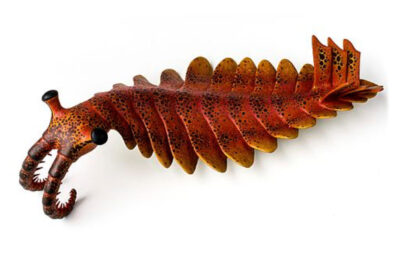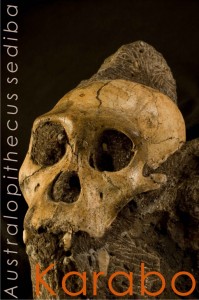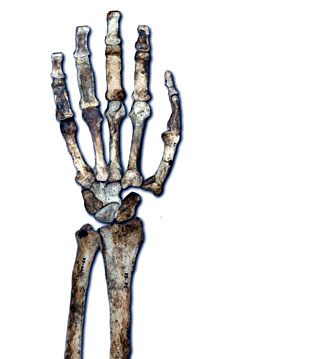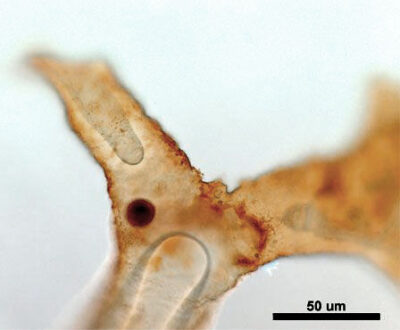by Richard William Nelson | Dec 11, 2011
 Anomalocaris, an ancient three-foot-long shrimp-like creature, is an evolutionary anomaly. Anomalocaris (pictured left) is Greek for “anomaly shrimp.”
Anomalocaris, an ancient three-foot-long shrimp-like creature, is an evolutionary anomaly. Anomalocaris (pictured left) is Greek for “anomaly shrimp.”
The origin of this marine creature’s compound eye, a species first discovered by Charles Doolittle Walcott in the Canadian Rockies at an elevation of over 7,000 feet above sea level, has long puzzled evolution scientists. Where did the freakish eyes originate, and how did they end up in the Canadian Rockies?
The findings have no natural explanation.
Continue Reading
by Richard William Nelson | Sep 18, 2011
 In the journal Science, the September 9 edition, a collection of reports generated a storm of controversy on the evolutionary status of Australopithecus sediba. Nicknamed Karabo, meaning “answers,” the fossils have emerged as the latest human ancestor candidate.
In the journal Science, the September 9 edition, a collection of reports generated a storm of controversy on the evolutionary status of Australopithecus sediba. Nicknamed Karabo, meaning “answers,” the fossils have emerged as the latest human ancestor candidate.
While last week’s topic focused on Karabo’s transitional links, this week examines the dating of these two remarkable fossilized skeletons recovered from the Malapa site in South Africa.
The Karabo dating surprised the investigators.
Continue Reading
by Richard William Nelson | Sep 12, 2011
 The Australopithecus sediba saga intensified last week with a new series of reports published in the journal of Science. The journal is the official weekly publication of the American Association for the Advancement of Science, AAAS.
The Australopithecus sediba saga intensified last week with a new series of reports published in the journal of Science. The journal is the official weekly publication of the American Association for the Advancement of Science, AAAS.
Last week’s edition (cover pictured left) featured eight articles and news reports specifically on A. sediba, inflaming a flurry of speculations on the human “missing link.”
This last week was the second Science edition to focus on human evolution findings in South Africa.
Continue Reading
by Richard William Nelson | Jan 2, 2011
 Leslie Stahl, long-time CBS journalist, interviewed on 60 Minutes with Mary Schweitzer in December, marking a new paleontology arena – the field of dinosaur soft tissue.
Leslie Stahl, long-time CBS journalist, interviewed on 60 Minutes with Mary Schweitzer in December, marking a new paleontology arena – the field of dinosaur soft tissue.
Schweitzer, an American paleontologist at North Carolina State University, unexpectedly discovered soft tissues from a Tyrannosaurus rex bone sent from the Museum of the Rockies in Montana.
Schweitzer’s controversial report, “Gender-Specific Reproductive Tissue in Ratites and Tyrannosaurus rex,” published in the journal Science in 2005, revolutionized our understanding of fossil preservation.
Continue Reading
by Richard William Nelson | Nov 28, 2010
 Craig Venter, the maverick American biologist and businessman, captured worldwide attention by announcing the creation of “the first synthetic species,” nicknamed “Synthia.” Venter has the credentials. In 2000, Venter, along with Francis Collins of the National Institutes of Health, jointly announced the complete mapping of the human genome.
Craig Venter, the maverick American biologist and businessman, captured worldwide attention by announcing the creation of “the first synthetic species,” nicknamed “Synthia.” Venter has the credentials. In 2000, Venter, along with Francis Collins of the National Institutes of Health, jointly announced the complete mapping of the human genome.
In a 60-Minute CBS interview with Steve Kroft (pictured right), in the aired TV segment entitled “J. Craig Venter: Designing Life,” CBS touted that Venter’s new synthetic species “gets its genetic instructions from a synthetic chromosome made by man, not nature.”
Continue Reading
 Anomalocaris, an ancient three-foot-long shrimp-like creature, is an evolutionary anomaly. Anomalocaris (pictured left) is Greek for “anomaly shrimp.”
Anomalocaris, an ancient three-foot-long shrimp-like creature, is an evolutionary anomaly. Anomalocaris (pictured left) is Greek for “anomaly shrimp.”

 The
The 
 Craig Venter
Craig Venter